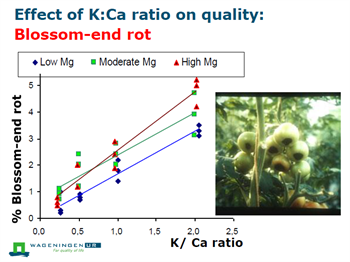Each one of the three major Cations in the plant nutrition (Potassium (K+), Calcium (Ca++), Magnesium (Mg++)) has a special functionality in the plant growth and has an important role in determining the crop yield and quality.

When growers determines fertilization program they tend to ensure the application of the required cation quantity and gives less attention to the ratio between the cations that has an important impact on the plant health as well
The importance of maintaining the right ratio is clearly demonstrated in the case of Blossom-end rot a physiological phenomenon that causing a considerable damage in vegetable crops mainly in tomato and pepper.
The incidence of blossom-end rot (BER) is generally associated with a calcium (Ca) deficiency in the distal portion of tomato fruits. The visible symptom is a necrotic lesion, which is presumed to be a consequence of cell death and the subsequent leakage of solutes into the extracellular space.
As it can be seen in the graph above, high K/Ca ratio leads to higher occurrence of Blossom-end rot, this is magnified even further at the higher Mg levels. This graph shows that high levels of K+ and Mg++ in the soil solution Interfere to the uptake of Ca++ by the plant and cause symptoms of Ca++ deficiency.
The concentrations of the different Cations that are dissolved and available in the soil / substrate solution influence the ratio between the Cations that are absorbed and accumulated at the different plant organs, tissues and fruits. For this reason it is highly recommended to monitor the soil /substrate solution on regular basis and make sure that the Cations concentrations and the ratio between them meets the specific crop nutritional requirements.




